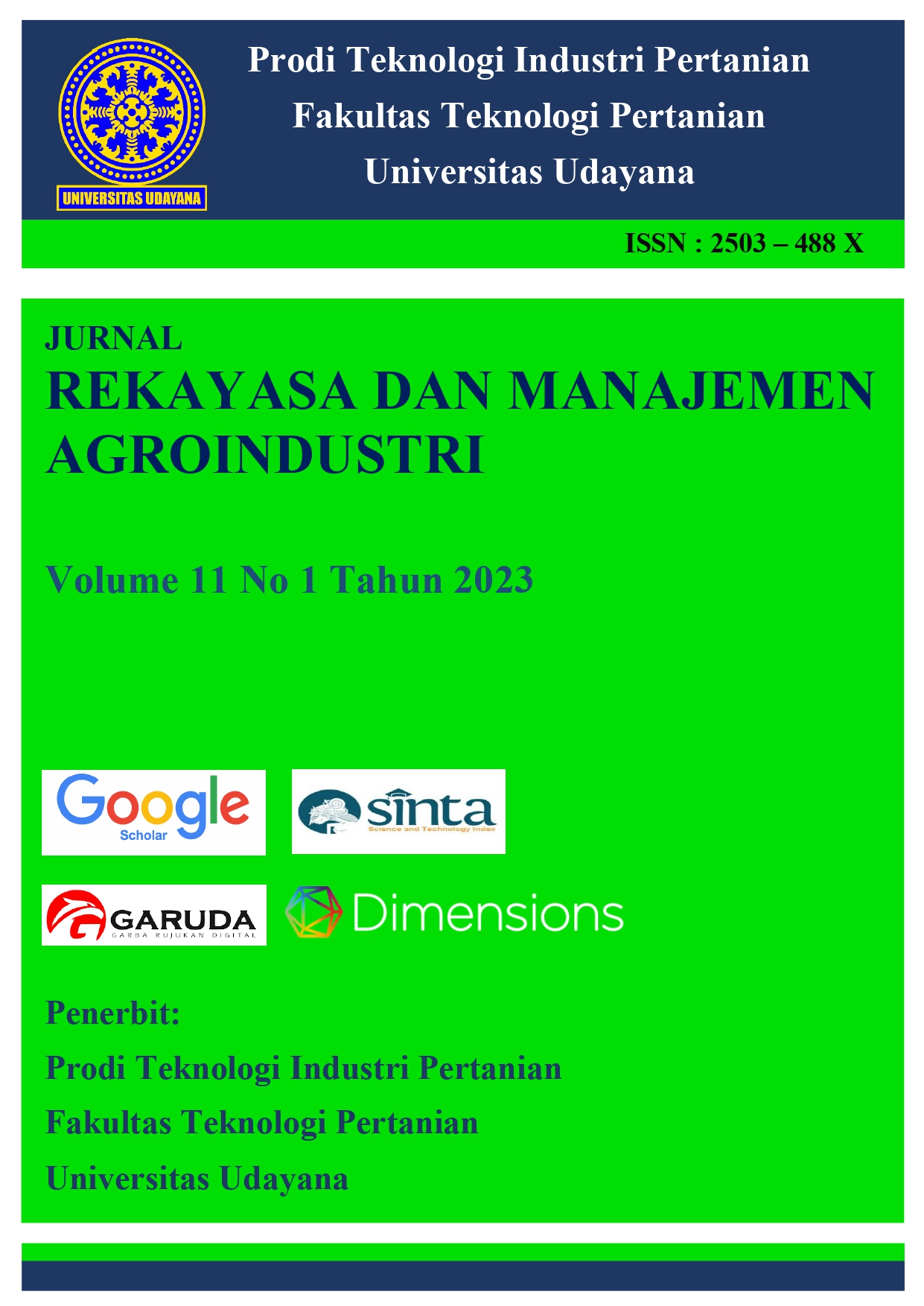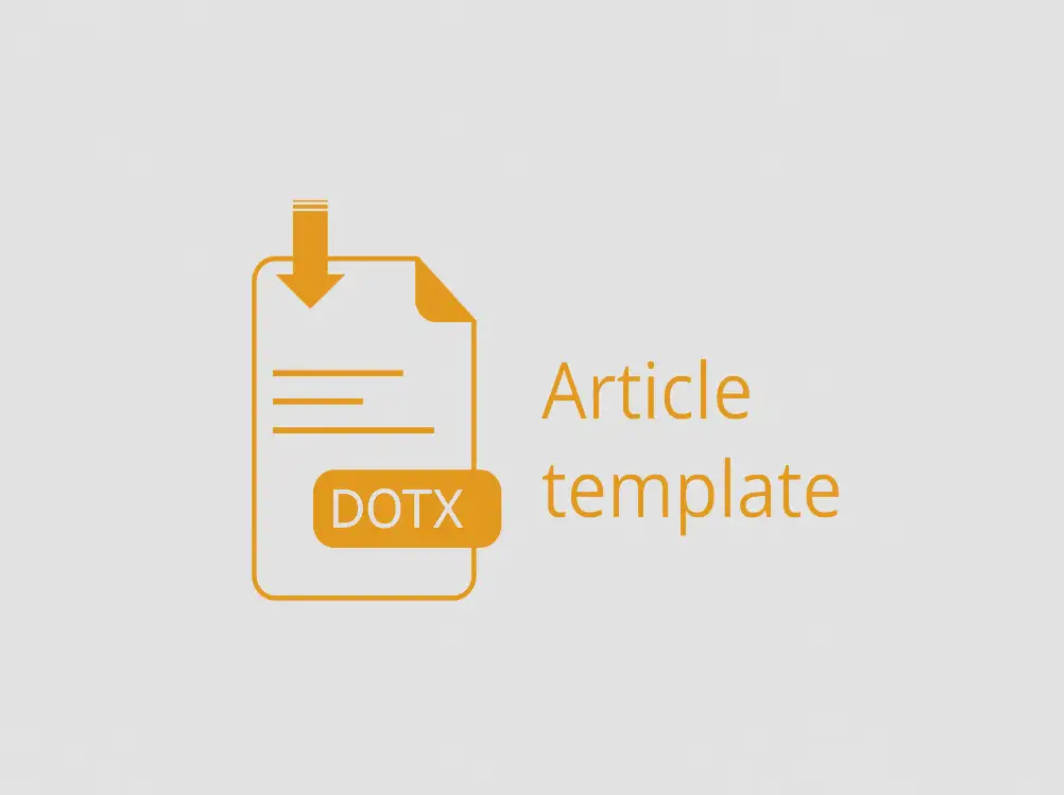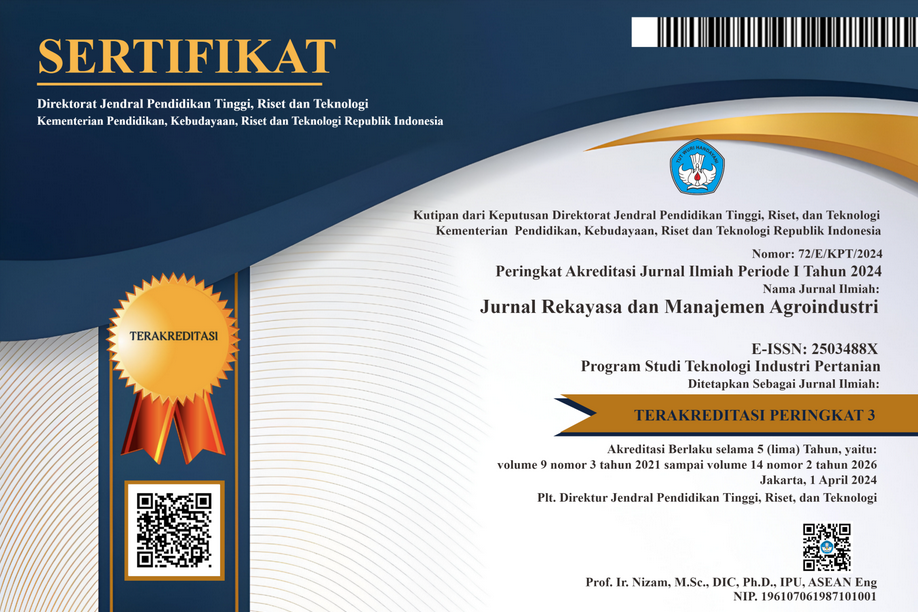Sintesis Mikroemulsi Menggunakan Surfaktan dan Minyak Atsiri Kulit Buah Lemon (Citrus limon) Sebagai Face Mist
Abstract
This study aims to determine the effect of the ratio of the mixture of surfactants and essential oil of lemon rind (Citrus limon) and determine the ratio of surfactant and essential oil of lemon rind (Citrus limon) to obtain the best microemulsion characteristics. This experiment used a completely randomized design with step 1 ratio of surfactant mixture (Tween 20: Tween 80: Span 80) which was 97: 2.75: 0.25; 97:2.5:0.5; 97:2.25:0.75; 97:2.0:1; 97:1.75; 1.25. Then, in step 2 the ratio of surfactant and lemon peel essential oil was 90:10; 87.5: 12.5; 85:15; 82.5:17.5; 80:20. Data were analyzed using analysis of variance using excel. The results showed that the ratio of the mixture of surfactants and lemon peel essential oil had an effect on the characteristics of the resulting microemulsion. The ratio of surfactant mixture 97: 2.75: 0.25 (Tween 20: Tween 80: Span 80) was the best treatment for making lemon peel essential oil microemulsion with the lowest turbidity values ??before and after centrifugation, namely 0.245±0.010% and 0.203±0.059 %. The ratio of surfactant and essential oil of lemon peel 85:15 was the best treatment with turbidity index values ??before and after centrifugation 0.298±0.037% and 0.334±0.161%, respectively. Lemon peel essential oil microemulsion has a particle size of 1272.2 nm and a potential zeta value of 0 mV. Lemon peel essential oil microemulsion 85:15 was stable for 8 weeks of storage.
Downloads
References
Cho, Y. H., S. Kim, E. K. Bae, C. K. Mok, and J. Park. 2008. Formulation of a cosurfactant-free m/a microemulsion using nonionic surfactant mixtures. Journal of Food Science. 73(3):115 -121.
Dwipaya, I. M. 2021. Pengaruh rasio campuran surfaktan dan minyak atsiri jahe (Zingiber officinale var. Amarum) ter-hadap karakteristik mikroemulsi yang dihasilkan. Skripsi. Tidak dipublikasikan. Fakultas Teknologi Pertanian. Universitas Udayana, Bali.
Gao, L., Zhang, D and Chen, M. 2008. Drug nanocrystals for the formulation of poorly soluble drugs and its application as a potential drug delivery system. Journal of Nanoparticle Reseach. 10(5): 845 – 862.
Hasrawati, A., N. Hasyim., N. A. Irsyad. 2016. Pengembangan formulasi mikroemulsi minyak sereh (Cymbopongon nar-dus) menggunakan emulgator surfaktan nonionik. Jurnal Fitofarmaka Indonesia. 3(1): 151 – 154.
Hendra., A. P., L. Suhndra., Wrasiati. L.P. 2021. Karakteristik mikroemulsi minyak daun sirih (Piper betle L.) pada perla-kuan rasio campuran surfaktan dan minyak daun sirih. Jurnal Rekayasa dan Manajemen Agroindustri. 9(4): 582 – 591.
Hui, Y.H. 1996. Bailey’s Industrial Oil and Fat Products. John Willey and Sons, Inc.
Johny, F. 2012. Karakteristik konduktivitas termal suspensi partikel submikrom seng oksida yang disintesis menggunakkan planetary ball mill. Skripsi. Tidak dipublikasikan. Fakultas Teknik. Universitas Indonesia, Depok.
McClements, D.J. 2005. Food Emulsion: Principles, Practice, and Techniques. CRC Press, Florida.
Mitsui, T. 1998. New Cosmetic Science. Elsevier Science B.V., Amsterdam
Mohanapriya, M., L. Ramaswamy., R. Rajendran. 2013. Health and medicinal properties of lemon (Citrus Limonum). International Journal Of Ayurvedic And Herbal Medicine. 3(1): 1095 – 1100.
Mohanraj, V.J and Y. Chen. 2006. Nanoparticles: A review. Tropical Journal pf Pharmaceutical Research. 5(1): 561 – 573.
Nizhar, U.M. 2012. Level optimum sari buah lemon (Citrus lemon) sebagai bahan penggumpal pada pembentukan curd keju cottage. Skripsi. Tidak Dipublikasikan. Program Studi Teknologi Hasil Ternak. Fakultas Peternakan. Uni-versitas Hasanudin, Makasar.
Perangin-angin, B dan A. Mardiyah. 2017. Identifikasi kemurnian minyak nilam dengan pengamatan spektrum fluo-ressensi. Agrium. 21(1): 20 – 25.
Permana, I. D. G. M dan L. Suhendra. 2015. Optimasi konsentrasi virgin coconut oil dalam mikroemulsi o/w dengan tiga surfaktan sebagai pembawa senyawa bioaktif. Media Ilmiah Teknologi Pangan. 2(2): 106 – 114.
Priambodo, S.O. 2015. Enkapsulasi minyak lemon (Citrus lemon) menggunakan penyalut β-siklodekstrin terasetilasi. Skripsi. Tidak dipublikasikan. Fakultas Matematika dan Ilmu Pengetahuan Alam. Universitas Negeri Semarang, Semarang.
Sari, K. D., dan R. S. Dhamar Lestari. 2015. Pengaruh waktu dan kecepatan pengadukan terhadap emulsi minyak biji matahari (Helianthus annuus L.) dan air. Jurnal Integrasi Proses. 5 (3) : 155-159.
Srikant, K., V.R.M Gupta., S.R. Manvi., N. Devanna. 2012. Particulate carrier system: a review. International Research Journal of Pharmacy. 3(11):22 – 26.
Suhendra, L., S. Raharjo, P. Hastuti., C. Hidayat. 2012. Formulasi dan stabilitas mikroemulsi m/a sebagai pembawa fuco-xanthin. Agritech. 32(3): 230 – 239.
Suhendra, L., S. Raharjo, P. Hastuti., C. Hidayat. 2014. Stabilitas mikroemulsi fucoxanthin dan efektifitasnya dalam menghambat foto oksidasi vitamin c pada model minuman. Agritech. 34(2): 138 – 145.
Suryana, 2013. Analisis kualitas air sumur dangkal di kecamatan biringkayana kota makasar. Skripsi. Tidak dipublikasi-kan. Fakultas Teknik. Universitas Hasanuddin, Makassar.

Ciptaan disebarluaskan di bawah Lisensi Creative Commons Atribusi-BerbagiSerupa 4.0 Internasional.
Seluruh artikel di Jurnal ini dapat disebarluaskan atas tetap mencantumkan sumber yang syah. Identitas judul artikel tidak boleh dihilangkan. Penerbit tidak bertangggung jawab terhadap naskah yang dipublikasikan. Isi artikel menjadi tanggung jawab Penulis.














